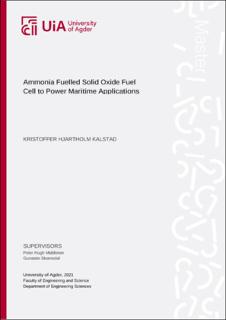| dc.contributor.author | Kalstad, Kristoffer Hjartholm | |
| dc.date.accessioned | 2021-10-12T08:00:56Z | |
| dc.date.available | 2021-10-12T08:00:56Z | |
| dc.date.issued | 2021 | |
| dc.identifier.citation | Kalstad, K.H. (2021) Ammonia Fuelled Solid Oxide Fuel Cell to Power Maritime Applications (Master's thesis). University of Agder, Grimstad. | en_US |
| dc.identifier.uri | https://hdl.handle.net/11250/2789156 | |
| dc.description | Master's thesis in Renewable energy (ENE500) | en_US |
| dc.description.abstract | Ammonia fuelled solid oxide fuel cell (SOFC) systems are regarded as a promising alternative for energy production due to high efficiency and low environmental impact. Ammonia is a carbon free compound with high energy density, low production cost and much simpler transport-and storage properties than hydrogen. The state-of-the-art SOFC contains a Ni/YSZ anode which has proven to be an effective catalyst to crack ammonia at intermediate temperatures (∼700°C). In this study an experimental work was conducted using an Open Flange SOFC test set-up with a planar anode-supported single cell consisting of a Ni/YSZ anode, YSZ electrolyte, and LSM cathode. The objective of the study is to investigate the feasibility of using vaporised ammonia solution as fuel in SOFC systems. For safety reasons the experimental supply of ammonia was from an aqueous solution of 32 wt %. The experiments were divided into two parts.In the first part three variations of ammonia concentration (32wt%, 15.2wt% and 5.9wt%) were supplied to the fuel cell to investigate the current –voltage behaviour obtained at 750 ⁰C. Maximum power densities at 45 mW/cm2, 37.5 mW/cm2, and 25 mW/cm2respectively were observed which were consistent with the reduction in partial pressure and mass flow of ammonia as the concentration of ammonia in the aqueous solution was decreased. The second part of the experiment was a comparison of 32wt% ammonia solution with pure hydrogen and a 3:1 hydrogen/nitrogen mixture. It was observed that the maximum power densities of the32%wt ammonia solution reached power densities comparable to the ones obtained with hydrogen as fuel at 850°C.. | en_US |
| dc.language.iso | eng | en_US |
| dc.publisher | University of Agder | en_US |
| dc.rights | Attribution-NonCommercial-NoDerivatives 4.0 Internasjonal | * |
| dc.rights.uri | http://creativecommons.org/licenses/by-nc-nd/4.0/deed.no | * |
| dc.subject | ENE500 | en_US |
| dc.title | Ammonia Fuelled Solid Oxide Fuel Cell to Power Maritime Applications | en_US |
| dc.type | Master thesis | en_US |
| dc.rights.holder | © 2021 Kristoffer Hjartholm Kalstad | en_US |
| dc.subject.nsi | VDP::Teknologi: 500::Kjemisk teknologi: 560::Elektrokjemi: 561 | en_US |
| dc.subject.nsi | VDP::Teknologi: 500::Elektrotekniske fag: 540::Elkraft: 542 | en_US |
| dc.source.pagenumber | 88 | en_US |

